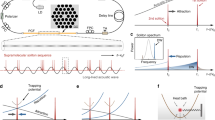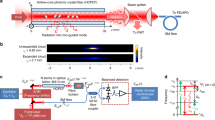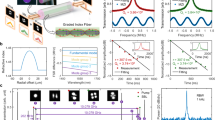Abstract
Multidimensional solitary states (MDSS)—self-sustained wavepackets—have attracted renewed interest in many different fields of physics. They are of particular importance in nonlinear optics, especially for the nonlinear propagation of ultrashort pulses in multimode fibres, which contain rich spatiotemporal intermodal interactions and dynamics, albeit often in an unstable manner. Here, we report the observation of the formation of highly stable multidimensional solitary states in a molecular gas-filled large-core hollow-core fibre. We experimentally and numerically demonstrate the creation of MDSS by multimillijoule, subpicosecond near-infrared pulses and the underlying physics. We find that the MDSS have a broadband redshifted spectra with an uncommon negative quadratic spectral phase at the output of the hollow-core fibre, originating from Raman enhancement due to the strong intermodal nonlinear interactions. The spatial and temporal localization of MDSS enables the compression of the broadened pulses at the output to 10.8 fs by simple linear propagation in a piece of fused silica. The high spatiotemporal quality of MDSS is further verified by high-harmonic generation. Our results present new opportunities for studying multimodal spatiotemporal dynamics in the high-energy regime. This work also presents a route toward a new class of compact, tunable and high-energy spatiotemporally engineered coherent light sources based on picosecond ytterbium technology.
This is a preview of subscription content, access via your institution
Access options
Access Nature and 54 other Nature Portfolio journals
Get Nature+, our best-value online-access subscription
$29.99 / 30 days
cancel any time
Subscribe to this journal
Receive 12 print issues and online access
$209.00 per year
only $17.42 per issue
Buy this article
- Purchase on Springer Link
- Instant access to full article PDF
Prices may be subject to local taxes which are calculated during checkout





Similar content being viewed by others
Data availability
The data that support the plots within this paper and other findings of this study are available from the corresponding author (R.S.) on reasonable request.
Code availability
The computer code used in this study will be made available from the corresponding author (R.S.) on reasonable request.
References
Grelu, P. & Akhmediev, N. Dissipative solitons for mode-locked lasers. Nat. Photon. 6, 84–92 (2012).
Kartashov, Y. V., Astrakharchik, G. E., Malomed, B. A. & Torner, L. Frontiers in multidimensional self-trapping of nonlinear fields and matter. Nat. Rev. Phys. 1, 185–197 (2019).
Chen, Z., Segev, M. & Christodoulides, D. N. Optical spatial solitons: historical overview and recent advances. Rep. Prog. Phys. 75, 086401 (2012).
Kivshar, Y. S. & Agrawal, G. Optical Solitons: from Fibers to Photonic Crystals (Academic, 2003).
Malomed, B., Torner Sabata, L., Wise, F. & Mihalache, D. On multidimensional solitons and their legacy in contemporary atomic, molecular and optical physics. J. Phys. B 49, 170502 (2016).
Knight, P. & Miller, A. Optical Solitons: Theory and Experiment Vol. 10 (Cambridge Univ. Press, 1992).
Malomed, B. A., Mihalache, D., Wise, F. & Torner, L. Spatiotemporal optical solitons. J. Opt. B 7, R53 (2005).
Stegeman, G. I. & Segev, M. Optical spatial solitons and their interactions: universality and diversity. Science 286, 1518–1523 (1999).
Travers, J. C., Grigorova, T. F., Brahms, C. & Belli, F. High-energy pulse self-compression and ultraviolet generation through soliton dynamics in hollow capillary fibres. Nat. Photon. 13, 547–554 (2019).
Wright, L. G., Christodoulides, D. N. & Wise, F. W. Spatiotemporal mode-locking in multimode fiber lasers. Science 358, 94–97 (2017).
Wright, L. G., Christodoulides, D. N. & Wise, F. W. Controllable spatiotemporal nonlinear effects in multimode fibres. Nat. Photon. 9, 306–310 (2015).
Eftekhar, M. et al. Accelerated nonlinear interactions in graded-index multimode fibers. Nat. Commun. 10, 1–10 (2019).
Rishøj, L., Tai, B., Kristensen, P. & Ramachandran, S. Soliton self-mode conversion: revisiting Raman scattering of ultrashort pulses. Optica 6, 304–308 (2019).
Pourbeyram, H., Agrawal, G. P. & Mafi, A. Stimulated Raman scattering cascade spanning the wavelength range of 523 to 1750 nm using a graded-index multimode optical fiber. Appl. Phys. Lett. 102, 201107 (2013).
Tani, F., Travers, J. C. & Russell, P. S. J. Multimode ultrafast nonlinear optics in optical waveguides: numerical modeling and experiments in Kagomé photonic-crystal fiber. JOSA B 31, 311–320 (2014).
Russell, P. S. J., Hölzer, P., Chang, W., Abdolvand, A. & Travers, J. Hollow-core photonic crystal fibres for gas-based nonlinear optics. Nat. Photon. 8, 278–286 (2014).
Trabold, B., Abdolvand, A., Euser, T., Walser, A. & Russell, P. S. J. Amplification of higher-order modes by stimulated Raman scattering in H2-filled hollow-core photonic crystal fiber. Opt. Lett. 38, 600–602 (2013).
Wright, L. G. et al. Self-organized instability in graded-index multimode fibres. Nat. Photon. 10, 771–776 (2016).
Wright, L. G. et al. Mechanisms of spatiotemporal mode-locking. Nat. Phys. 16, 565–570 (2020).
Wright, L. G., Renninger, W. H., Christodoulides, D. N. & Wise, F. W. Spatiotemporal dynamics of multimode optical solitons. Opt. Express 23, 3492–3506 (2015).
Marcatili, E. A. & Schmeltzer, R. Hollow metallic and dielectric waveguides for long distance optical transmission and lasers. Bell Labs Tech. J. 43, 1783–1809 (1964).
Fan, G. et al. Hollow-core-waveguide compression of multi-millijoule CEP-stable 3.2 μm pulses. Optica 3, 1308–1311 (2016).
Nisoli, M., De Silvestri, S. & Svelto, O. Generation of high energy 10 fs pulses by a new pulse compression technique. Appl. Phys. Lett. 68, 2793–2795 (1996).
Goulielmakis, E. et al. Single-cycle nonlinear optics. Science 320, 1614–1617 (2008).
Balciunas, T. et al. A strong-field driver in the single-cycle regime based on self-compression in a Kagome fibre. Nat. Commun. 6, 1–7 (2015).
Safaei, R. et al. Low energy pulse compression in hollow core fibers using hydrofluorocarbon molecular gas. OSA Continuum 2, 1488–1495 (2019).
Fan, G. et al. High energy redshifted and enhanced spectral broadening by molecular alignment. Opt. Lett. 45, 3013–3016 (2020).
Horak, P. & Poletti, F. in Recent Progress in Optical Fiber Research 3–25 (IntechOpen, 2012).
Fibich, G. & Gaeta, A. L. Critical power for self-focusing in bulk media and in hollow waveguides. Opt. Lett. 25, 335–337 (2000).
Mitschke, F. M. & Mollenauer, L. F. Discovery of the soliton self-frequency shift. Opt. Lett. 11, 659–661 (1986).
Skryabin, D., Luan, F., Knight, J. & Russell, P. S. J. Soliton self-frequency shift cancellation in photonic crystal fibers. Science 301, 1705–1708 (2003).
Nagy, T. et al. Generation of three-cycle multi-millijoule laser pulses at 318 W average power. Optica 6, 1423–1424 (2019).
Lu, C.-H. et al. Greater than 50 times compression of 1030 nm Yb: KGW laser pulses to single-cycle duration. Opt. Express 27, 15638–15648 (2019).
Balla, P. et al. Postcompression of picosecond pulses into the few-cycle regime. Opt. Lett. 45, 2572–2575 (2020).
Corkum, P. B. Plasma perspective on strong field multiphoton ionization. Phys. Rev. Lett. 71, 1994 (1993).
Popmintchev, T. et al. Bright coherent ultrahigh harmonics in the keV X-ray regime from mid-infrared femtosecond lasers. Science 336, 1287–1291 (2012).
Fermann, M. E. & Hartl, I. Ultrafast fibre lasers. Nat. Photon. 7, 868–874 (2013).
Jauregui, C., Limpert, J. & Tünnermann, A. High-power fibre lasers. Nat. Photon. 7, 861–867 (2013).
Schmidt, B. E., Hage, A., Mans, T., Légaré, F. & Wörner, H. J. Highly stable, 54 mJ Yb-InnoSlab laser platform at 0.5 kW average power. Opt. Express 25, 17549–17555 (2017).
Chen, B.-H. et al. Compression of picosecond pulses from a thin-disk laser to 30 fs at 4 W average power. Opt. Express 26, 3861–3869 (2018).
Acknowledgements
R.S. acknowledges financial support from the FRQNT Ph.D. scholarship programme. The research received funding from the Canada Foundation for Innovation (CFI), the Natural Sciences and Engineering Research Council of Canada (NSERC), and the Fonds de Recherche du Qubec sur la Nature et les Technologies (FRQNT). We thank P. B. Corkum, J. Powell and S. Beaulieu for discussions.
Author information
Authors and Affiliations
Contributions
R.S. performed the theoretical analysis and numerical simulations. R.S. and G.F. performed the experiment with the support of O.K. and K.L. R.S. and G.F. analysed the experimental data. R.S. wrote the manuscript with the support of G.F. and input from all other authors. F.L. supervised the project.
Corresponding authors
Ethics declarations
Competing interests
The authors declare no competing interests.
Additional information
Publisher’s note Springer Nature remains neutral with regard to jurisdictional claims in published maps and institutional affiliations.
Supplementary information
Supplementary Information
Supplementary Figs. 1–14, Sections 1–12, Equations 1–13 and Tables 1–2.
Rights and permissions
About this article
Cite this article
Safaei, R., Fan, G., Kwon, O. et al. High-energy multidimensional solitary states in hollow-core fibres. Nat. Photonics 14, 733–739 (2020). https://doi.org/10.1038/s41566-020-00699-2
Received:
Accepted:
Published:
Issue Date:
DOI: https://doi.org/10.1038/s41566-020-00699-2
This article is cited by
-
Spectral broadening and nonlinear mode coupling in a gas-filled hollow core capillary
Applied Physics B (2024)
-
Stability, modulation instability and wave solutions of time-fractional perturbed nonlinear Schrödinger model
Optical and Quantum Electronics (2024)
-
Physics of highly multimode nonlinear optical systems
Nature Physics (2022)
-
Exotic waves in multimode hollow-core fibres
Nature Photonics (2020)



